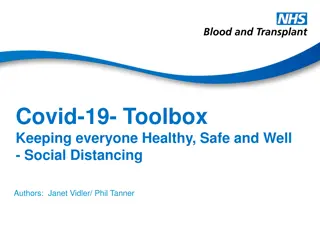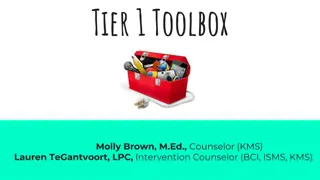
Safer Teleworking Guidelines for Home Workers
Enhance your teleworking safety with these guidelines. Learn how to navigate the challenges of working from home, minimize risks, and create a productive environment. From understanding home as a workspace to employer responsibilities, this guide covers it all.
Uploaded on | 0 Views
Download Presentation

Please find below an Image/Link to download the presentation.
The content on the website is provided AS IS for your information and personal use only. It may not be sold, licensed, or shared on other websites without obtaining consent from the author. If you encounter any issues during the download, it is possible that the publisher has removed the file from their server.
You are allowed to download the files provided on this website for personal or commercial use, subject to the condition that they are used lawfully. All files are the property of their respective owners.
The content on the website is provided AS IS for your information and personal use only. It may not be sold, licensed, or shared on other websites without obtaining consent from the author.
E N D
Presentation Transcript
COVID-19 GUIDE FOR TELE WORKING Toolbox Talk EHSEC
PURPOSE This Guide contains simple guidelines to help home workers cope with the new situation of compulsory home-based restraint, and being able to perform without exposing themselves to risks that could harm their psychosomatic health. EHSEC 2
HOME AS A WORKING ENVIRONMENT HOME IS: usually not intended for systematic long hours image of relaxation and enjoyable moments Even if the premises ensure the basic specifications for the execution of working, this period makes it difficult. Normal teleworking takes place during hours when other members are away, while the current circumstances require the family members to be at home for the same period of time. This creates additional stress, distractions and obligations for working parents, making homework more difficult, less productive and potentially stressful. EHSEC 3
HOME AS A WORKING ENVIRONMENT AND EMPLOYERS RESPONSIBILITIES The existing legal framework does not adequately cover teleworking even at European level The employer does not have, nor is it allowed to have, control over the workplace of the employee, therefore he cannot impose safe working methods in this area. It is very difficult to set a telework schedule In the event of an accident it is very difficult to determine the employer's responsibility The employer must advise the employee on practices for safer work even at home EHSEC 4
DANGERS AT THE TELE WORKING AREA HOME Common hazards in the home are: Stumbling over obstacles Slipping Fall from stairs Hit by falling objects Electric shock Manual cargo handling Emergency / fire, earthquake Anxiety The risks of using a Computer are categorized as follows: Equipment Natural Factors (Noise, Lighting, Temperature) Ergonomics EHSEC 5
GENERAL INSTRUCTIONS FOR SAFER WORK PRACTICING AT "HOME" Stumbling over obstacles : Be really careful for the presence of cables on the floor (eg power cables for laptops, vacuum cleaners, ballasts) Slipping: 1. Clean spilled liquids (water, infusions, etc.) that cause slipping. 2. When moping, inform your roommates (family members) and place a mobile slippery sign or object that blocks access. EHSEC 6
GENERAL INSTRUCTIONS FOR SAFER WORK PRACTICING AT "HOME" Fall from stairs: 1. Do not climb on chairs, tables, stools, etc. or other improvised construction Get a "L" type staircase or a three-step, CE certified When you climb a ladder, there should be a second person, who will hold the ladder 2. 3. Hit from falling objects: 1. Avoid placing everyday objects in high places 2. Take care of the stabilization of furniture equipment such as shelves, cabinets, bookshelves etc 3. Heavy items are stored on low shelves. EHSEC 7
GENERAL INSTRUCTIONS FOR SAFER WORK PRACTICING AT "HOME" Individual or Family Action Plan, as well as the supply or ensuring adequacy of firefighting equipment, is necessary to deal with an Emergency such as a fire or earthquake. FIRE: 1. Know exactly where the fire extinguishers are in your house Transmission Paths of SARS-CoV-2 Supply your home with adequate number of fire extinguishers In case of fire during cooking the use of water on the utensil is PROHIBITED. Cover the pot or pan with the lid that comes with it or with a wet towel It is PROHIBITED to throw water in a fire created by a short circuit in electrical / electronic equipment. 2. 3. 4. EHSEC 8
GENERAL INSTRUCTIONS FOR SAFER WORK PRACTICING AT "HOME" EARTHQUAKE: Create a family earthquake plan. Locate safe places in each room (under tables, desks). Locate dangerous places (windows, mirrors, hanging objects, fireplaces and tall furniture). Set the emergency meeting point of your family, in case you get lost, when evacuating your home. Choose a person (friend or relative) that your family members can call after the earthquake and notify on your situation 1. 2. 3. 4. 5. EHSEC 9
GENERAL INSTRUCTIONS FOR SAFER WORK PRACTICING AT "HOME" Work stress: Work stress is what is created by performing a task Create a stable personal work space (dining room, living room), which will help you get in the mood for work. Create a work schedule and make sure it is followed Create your personal routine, such as having a coffee alone, with a roommate or even with a remote friend using video chats. Explain to your family that you work and that you can not be distracted from your duties to do housework Work in remote groups, using telephones, video conferencing, or exchanging information by email. 1. 2. 3. 4. 5. EHSEC 10
GENERAL INSTRUCTIONS FOR SAFER WORK PRACTICING AT "HOME" To deal with stress: 1. Apply simple relaxation techniques (breathing, relaxation, meditation, positive vision) Get into a physical exercise program . Follow a diet plan that includes fruits, vegetables and plenty of fluids . Smile Laugh Sleep well Small Joys. Do the simple things you enjoy (not expensive, not time consuming, that can be done immediately and quickly) 2. 3. 4. 5. 6. 7. EHSEC 11
INSTRUCTIONS FOR SAFE USE OF COMPUTERS AT "HOME" Working with visual data display (DSE) poses a number of risks associated with the use of the equipment, mainly musculoskeletal disorders, vision problems and mental fatigue. Display: Adjust the brightness and contrast of the screen The screen should be placed in front of you (not on the side) and at a height slightly below eye level If you use a Laptop for a long time, then it is necessary to use an external keyboard and mouse 1. 2. 3. EHSEC 12
GENERAL INSTRUCTIONS FOR SAFER WORK PRACTICING AT "HOME" Office furniture/Desk: The table or desk must be adequately dimensioned, have smooth edges and corners and allow arm and hand support. 1. Seat: It must be stable, allow freedom of movement & comfortable posture. Have a sufficient back to support its entire surface & gentle protrusion at the level of the back Handrails for elbow rest should not obstruct access to the table. 1. 2. 3. EHSEC 13
GENERAL INSTRUCTIONS FOR SAFER WORK PRACTICING AT "HOME" Positions that should be avoided: EHSEC 14
GENERAL INSTRUCTIONS FOR SAFER WORK PRACTICING AT "HOME" Noise: can cause distraction, irritability, discomfort with possible psychosomatic charging. Noise comes from: noisy machines, from outside or be caused by the family members . For these reasons, you should: Place noisy machines such as printers in remote parts of the house Adjust the volume of the home telephone to its lowest level. Set personal telephones in low volume or silent operation. Keep the windows of your home closed to reduce outside noise. Manage your involvement with your family members, and if possible reduce both the frequency and duration of your work breaks. Especially for children, you can plan quiet activities or alternate supervision with your partner. 1. 2. 3. 4. 5. 6. EHSEC 15
GENERAL INSTRUCTIONS FOR SAFER WORK PRACTICING AT "HOME" Working ergonomically: EHSEC 16
GENERAL INSTRUCTIONS FOR SAFER WORK PRACTICING AT "HOME" Stress Relief Advice: Stand up regularly Take short breaks Do stress relief 1. 2. 3. exercises 4. Take deep breaths EHSEC 17
GENERAL INSTRUCTIONS FOR SAFER WORK PRACTICING AT "HOME" EHSEC 18
GENERAL INSTRUCTIONS FOR SAFER WORK PRACTICING AT "HOME" EHSEC 19






















